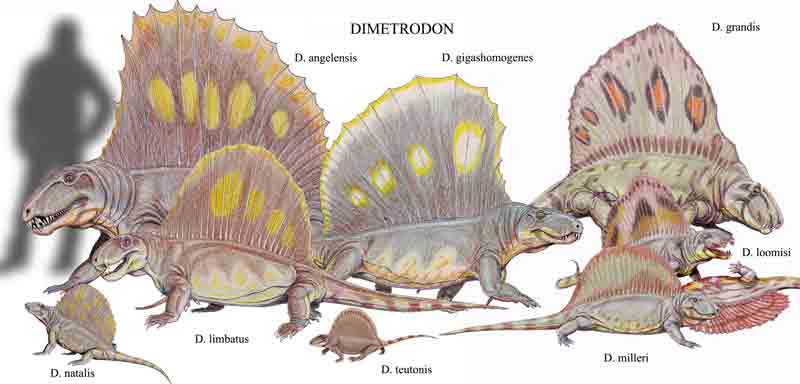Rare ! Neural Spine Fossil Vertebra Dorsal Sail Crest Prehistoric Primitive Reptile Pelicosaur Dimetrodon limbatus mm 22 x 9 x 5 Permian Paleozoic Collecting Paleontology Museum.
Difficult to find, very well preserved fossil find of high quality, with excellent evident details of bone structure and longitudinal groove. Not restored at all. Only a piece, as in photos.
Dimetrodon (whose name means "teeth of two measures") is an extinct genus of reptile sinapside sfenacodontide lived in the Permian period,
Cisuralian age, about 295-272 million years ago (Sakmariano-Kunguriano).
The most famous feature of the Dimetrodon is undoubtedly the great dorsal veil, similar to that of the modern basilisk (or the more known Spinosaurus), formed by vertically elongated spinal processes connected to each other by a layer of skin. The animal was four-legged and had a tall, curved skull with large teeth of different sizes placed along the jaws.
Although its appearance and physiology make it look like reptiles and in popular culture is often mistaken for a dinosaur or their contemporary, Dimetrodon became extinct some 40 million years before the appearance of the dinosaurs. Dimetrodon is more closely related to mammals, although it is not a direct ancestor. It belongs to a group traditionally called "reptiles similar to mammals" (Synapsida, Pelycosauria, Sphenacodontidae, Sphenacodontinae).

Dimetrodon was probably one of the superpredators of Cisuralian ecosystems, hunting and feeding on fish and tetrapods, including reptiles and amphibians, while smaller species of dimetrodons might have had different ecological roles.
Since its discovery in 1878, over a dozen species ascribed to the genus have been described. These varied in size, with a length from 1.7 meters to 4.6 meters and it is estimated that its weight was around 28 to 250 kilograms. The largest known species is D. angelensis, while the smallest species is D. teutonis only 60 centimeters.
The first description of the Dimetrodon fossils supplied by Cope was the species Clepsydrops limbatus, from the Red Bed of Texas. Later, the species was changed from C. limbatus to a species of Dimetrodon, becoming D. limbatus.
Paleontologists have proposed several hypotheses on the effective function of sailing in life: one of the first theories was their use in the camouflage of the animal, which could thus hide among the reeds while waiting for prey. Another rather fanciful hypothesis is that it worked like a real sail, for the movement in the water of the animal, capturing the wind. Furthermore, it was thought that the long neural spines had the function of trunk stabilizers limiting the vertical movement and making the lateral one more effective.
It was finally proposed that the sail had a thermoregulation function, allowing the dimetrodonti to heat their bodies more effectively exposing them to the heat of the sun, angulating the sail according to the position of the star to cool off or to limit the flow of blood to the sail and maintain heat at night.
In the following years, numerous computer models were created to evaluate the effectiveness of Dimetrodon thermoregulation. It was thus estimated that a 200 kg individual would have to stay at least four hours in the sun to raise his body temperature by a few degrees. In addition, the sail was ineffective in releasing excess heat and did not allow the Dimetrodon to maintain a higher body temperature overnight.
It was thus suggested that the Dimetrodon's sail would have allowed the animal to be homeothermal, maintaining a constant, albeit low, body temperature. Homeothermia developed in animals such as Dimetrodon would then evolve in subsequent terapsids to develop endothermia (or warm blood) of mammals.
However, the little effectiveness of this process in the first smaller dimetrodonts and with lower ridges, and the discovery of endothermia in sfenacodontidi, has disassembled this hypothesis, and now it is mainly thought that the sail had only the function of display and sexual dimorphism , as well as in other animals such as Sphenacodon and Edaphosaurus.
Most of the fossils of dimetrodonts have been found in the south-west of the United States, and many of them come from a geological repository called Red Beds, Texas and Oklahoma. More recently, Dimetrodon fossils have also been found in Germany. All areas that at the time were part of the Euramerica supercontinent during the Lower Permian. In addition to the Dimetrodon, the most common tetrapods in all deposits of the Lower Permian of the USA are the amphibians Archery, Diplocaulus, Eryops and Trimerorhachis, the reptiliomorpha Seymouria, the reptile Captorhinus and the synapsids Ophiacodon, Diadectes, all tetrapods that constitute the so-called "chronofauna of the Permo-Carboniferous ", a fauna that has dominated the Euramerica for several million years, living lush and full of vegetation in a delta ecosystem.
Dimetrodon limbatus (synonyms):
Clepsydrops limbatus Cope, 1877
Dimetrodon incisivus Cope, 1878


